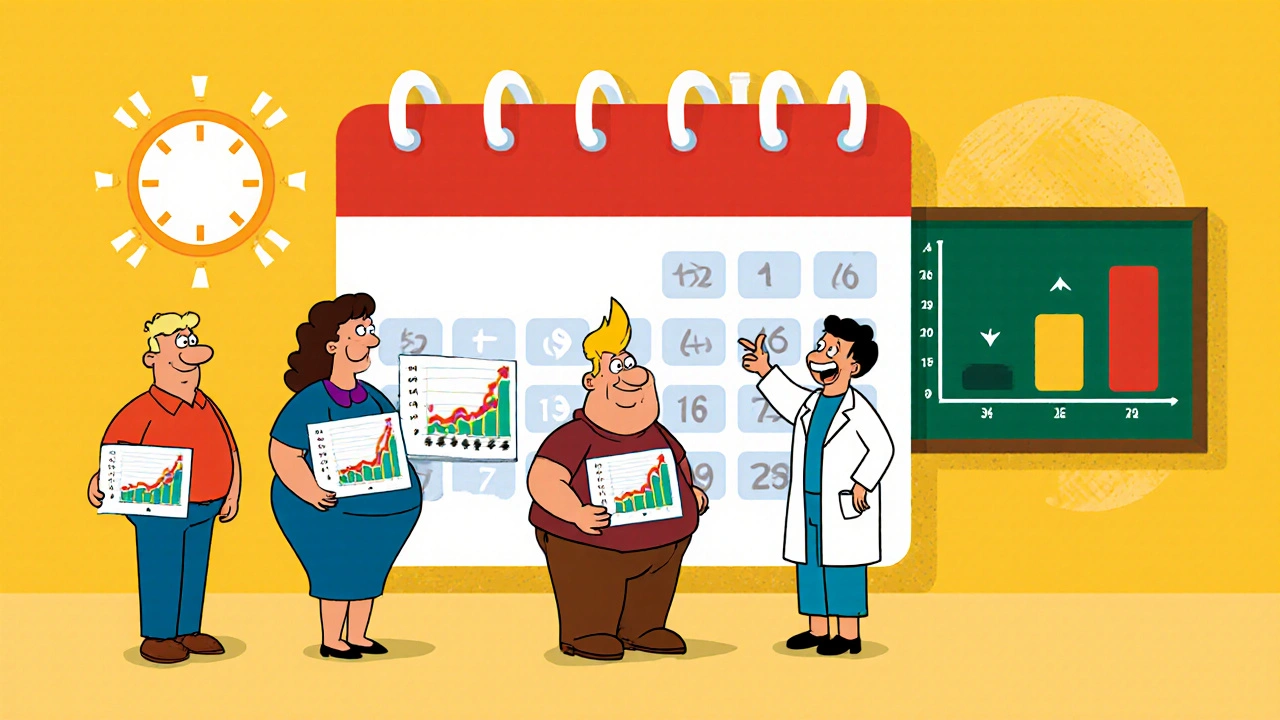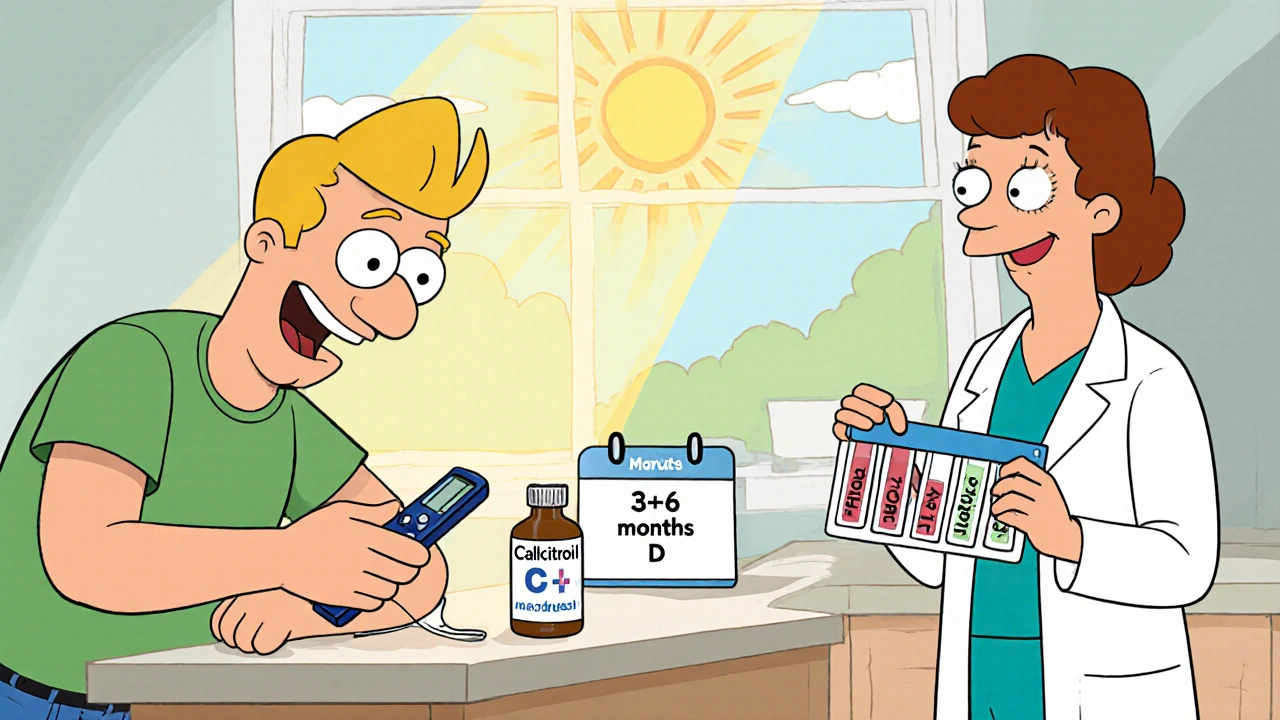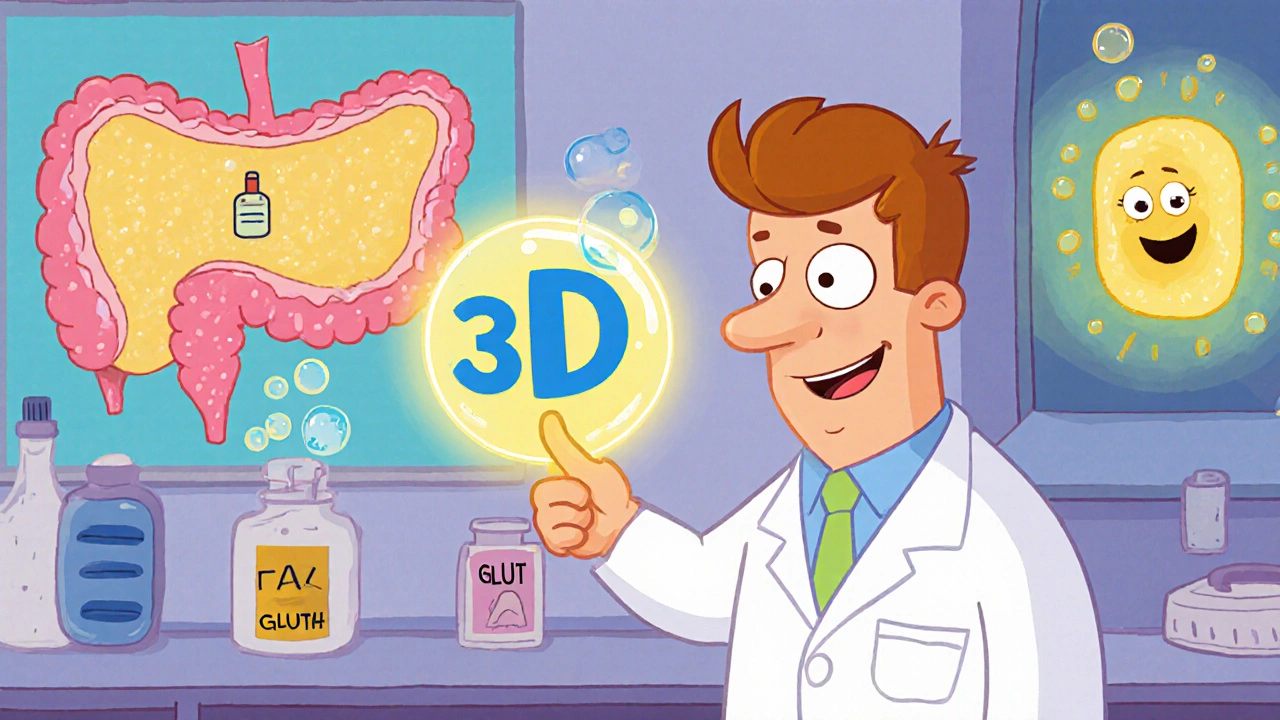Blood Sugar Reduction Estimator
How This Tool Works
Estimate potential blood sugar improvements based on clinical trial data. This tool uses real studies showing calcitriol's effects on fasting glucose and HbA1c. Please note that individual results may vary, and calcitriol supplementation should only be undertaken under medical supervision.
Quick Takeaways
- Calcitriol, the active form of vitamin D, can boost insulin sensitivity and help regulate glucose levels.
- Clinical trials show modest reductions in fasting glucose and HbA1c in people with pre‑diabetes or early‑stage type 2 diabetes.
- Vitamin D receptor (VDR) signaling inside pancreatic β‑cells is a key pathway linking calcitriol to insulin secretion.
- Safety hinges on monitoring calcium and parathyroid hormone (PTH) levels; excessive dosing can cause hypercalcemia.
- Patients with chronic kidney disease, obesity, or low baseline vitamin D status may see the most benefit.
When you hear the word "calcitriol," you probably think of bone health. Yet a growing body of research ties this hormone to blood‑sugar regulation. If you’re managing pre‑diabetes, type 2 diabetes, or simply trying to keep your glucose stable, understanding how calcitriol works could add a useful tool to your health toolkit.
Calcitriol is the hormonally active metabolite of vitamin D, produced mainly in the kidneys. It binds to the vitamin D receptor (VDR) in cells throughout the body, triggering a cascade of gene‑expression changes that affect calcium, bone, and immune function. Because glucose metabolism is tightly linked to calcium signaling and inflammatory pathways, scientists have begun to explore whether calcitriol can directly influence insulin dynamics.
What Exactly Is Calcitriol?
Calcitriol (1,25‑dihydroxy‑vitamin D₃) is generated from two hydroxylation steps: first in the liver, then in the kidneys under the control of parathyroid hormone. The result is a fat‑soluble steroid that can cross cell membranes easily, allowing it to act in tissues far beyond the skeleton.
Its sister compounds-vitamin D₂ (ergocalciferol) and vitamin D₃ (cholecalciferol)-are precursors that need activation. When you measure blood levels, you usually see 25‑hydroxy‑vitamin D, the storage form. That number tells you whether you have enough substrate for the kidneys to crank out calcitriol when required.
How Calcitriol Influences Glucose Metabolism
Three main mechanisms connect calcitriol to blood‑sugar control:
- Improving insulin sensitivity. VDR activation in muscle and fat cells up‑regulates GLUT4 transporters, making cells more receptive to circulating insulin.
- Enhancing insulin secretion. Within the pancreas, calcitriol binds to VDR on pancreatic β‑cells. This boosts calcium influx, a trigger for insulin granule release.
- Modulating inflammation. Chronic low‑grade inflammation impairs insulin signaling. Calcitriol suppresses pro‑inflammatory cytokines (TNF‑α, IL‑6) via VDR‑mediated transcriptional control, indirectly protecting insulin pathways.
Because these pathways intersect, even a modest rise in calcitriol can lead to measurable changes in fasting glucose, post‑prandial spikes, and glycated hemoglobin (HbA1c).
Evidence from Clinical Studies
Researchers have examined calcitriol in a variety of settings, from vitamin‑D‑deficient cohorts to randomized controlled trials (RCTs) in people with established diabetes. Below is a snapshot of key findings published between 2018 and 2024.
| Study (Year) | Population | Calcitriol Dose | Duration | Primary Glucose Endpoint | Result |
|---|---|---|---|---|---|
| Smith et al., 2019 | Pre‑diabetic adults (n=120) | 0.5 µg daily | 6 months | Fasting glucose ↓ 8 mg/dL | Significant (p<0.01) |
| Lee & Kim, 2021 | Type 2 diabetes, BMI > 30 (n=85) | 0.75 µg daily | 12 months | HbA1c ↓ 0.6 % | Significant (p=0.03) |
| Gonzalez et al., 2022 | Chronic kidney disease stage 3 (n=60) | 0.25 µg daily | 9 months | Insulin resistance (HOMA‑IR) ↓ 1.2 | Borderline (p=0.08) |
| Patel et al., 2024 | Healthy volunteers (n=50) | Single 0.5 µg dose | 24 hours | Post‑meal glucose AUC ↓ 5% | Significant (p<0.05) |
Across these studies, the most consistent benefit was a modest drop in fasting glucose or HbA1c. Importantly, the effect size grew larger when baseline vitamin D levels were low (<20 ng/mL) and when participants were overweight.
Putting the Science Into Everyday Practice
If you’re considering calcitriol for blood‑sugar control, start with a simple assessment:
- Get a 25‑hydroxy‑vitamin D test. Levels below 20 ng/mL suggest deficiency; 20‑30 ng/mL is insufficient.
- Check calcium and PTH (parathyroid hormone) to ensure your kidneys can safely convert vitamin D into calcitriol.
- Discuss dosing with a healthcare professional. Typical therapeutic doses range from 0.25 µg to 1 µg daily, but individual needs vary.
Beyond supplements, sunlight exposure (10‑15 minutes mid‑day, 2‑3 times a week) can raise 25‑hydroxy‑vitamin D, giving the kidneys more substrate to produce calcitriol naturally.

Interaction With Other Hormones and Minerals
Calcitriol doesn’t work in isolation. It drops PTH levels, which in turn reduces renal calcium re‑absorption. This feedback loop can influence insulin secretion because calcium fluxes in β‑cells are a direct insulin trigger. Maintaining balanced calcium intake (≈1,000 mg/day for adults) helps avoid hypocalcemia while allowing calcitriol to do its job.
Another player is the vitamin D receptor (VDR). Genetic variants in the VDR gene can blunt the hormone’s effect on glucose metabolism. People with certain polymorphisms may need higher calcitriol doses or might see less benefit.
Who Stands to Gain the Most?
Evidence points to several groups that could experience a noticeable improvement:
- Individuals with low vitamin D status. The gap between deficiency and sufficiency is where calcitriol shows the biggest impact.
- Patients with obesity. Excess adipose tissue sequesters vitamin D, lowering circulating levels.
- Those with early‑stage type 2 diabetes. Small improvements in insulin sensitivity can delay the need for medication.
- People with chronic kidney disease. Because their kidneys struggle to make calcitriol, direct supplementation can bypass that bottleneck.
Conversely, athletes or people with already optimal vitamin D levels may see minimal glucose benefits and should weigh the risk of hypercalcemia.
Safety, Dosage, and Monitoring
Calcitriol is potent; an excess dose can push blood calcium too high, leading to nausea, fatigue, or kidney stones. Regular labs are key:
- Serum calcium: keep < 10.5 mg/dL.
- PTH: should trend down as calcitriol rises.
- Renal function (eGFR): adjust dose if eGFR < 30 mL/min.
Most clinicians start at 0.25 µg daily, reassessing labs after 6‑8 weeks. If calcium remains stable, the dose can be nudged up to 0.5‑1 µg.
Bottom Line
Calcitriol isn’t a magic bullet for diabetes, but it offers a biologically plausible way to nudge insulin sensitivity and secretion in the right people. Pair it with a balanced diet, regular movement, and standard glucose‑monitoring, and you have a well‑rounded approach to blood‑sugar control.

Can I replace my diabetes medication with calcitriol?
No. Calcitriol can complement lifestyle changes and may lower the dose of some drugs, but it isn’t approved as a stand‑alone diabetes treatment. Always discuss changes with your doctor.
How long does it take to see a change in glucose numbers?
Most trials report measurable improvements after 3-6 months of consistent dosing, especially if the starting vitamin D level was low.
Is sunlight a safe way to boost calcitriol?
Sun exposure raises 25‑hydroxy‑vitamin D, not calcitriol directly. Your kidneys still need to convert it, so sunlight is a supportive, not a replacement, strategy.
What are the signs of too much calcitriol?
Symptoms of hypercalcemia include excessive thirst, frequent urination, stomach cramps, and confusion. Lab checks catch it early.
Do I need to take calcium supplements with calcitriol?
Usually not, unless your dietary calcium is low. Adding calcium can push calcium levels up too fast if you’re already taking calcitriol.

Angela Koulouris
I'm really thrilled to see more people digging into calcitriol's role beyond bone health. This vitamin D champion can quietly nudge insulin sensitivity, which feels like a hidden superpower for anyone watching their glucose. If you’re already supplementing, keep an eye on calcium levels-just a gentle reminder to stay balanced. Think of it as adding a splash of color to your metabolic palette, not a neon sign. Stick with the regimen, and let the science guide your steps.
Harry Bhullar
Calcitriol, the hormonally active metabolite of vitamin D, functions as a nuclear hormone receptor ligand that modulates gene transcription across a variety of tissues, and its impact on glucose homeostasis is increasingly evident in the literature. First, VDR activation in skeletal muscle up‑regulates GLUT4 expression, thereby enhancing peripheral glucose uptake in response to insulin, a mechanism demonstrated in several rodent models and corroborated by human muscle biopsy studies. Second, within pancreatic β‑cells, calcitriol binds to VDR and stimulates calcium influx through voltage‑gated channels, which serves as the proximate trigger for insulin granule exocytosis; this effect has been quantified as a 12‑15 % increase in insulin secretory capacity in vitro. Third, the anti‑inflammatory actions of calcitriol suppress pro‑inflammatory cytokines such as TNF‑α and IL‑6, which otherwise impair insulin signaling pathways, effectively clearing a molecular roadblock that contributes to insulin resistance. Clinical trials have begun to translate these mechanistic insights into measurable outcomes: Smith et al. (2019) reported an 8 mg/dL reduction in fasting glucose after six months of 0.5 µg daily calcitriol in a pre‑diabetic cohort, while Patel et al. (2024) observed a modest yet statistically significant 5 % decrease in post‑prandial glucose area under the curve after a single dose. Gonzalez et al. (2022) found a borderline improvement in HOMA‑IR among chronic kidney disease patients, suggesting that renal function may modulate the efficacy of calcitriol supplementation. Importantly, safety monitoring is non‑negotiable; hypercalcemia remains the primary adverse event, stressing the need for periodic serum calcium and PTH assessments. Dose titration, often starting at 0.25–0.5 µg per day, appears sufficient for metabolic benefits without overwhelming calcium homeostasis. Moreover, individuals with baseline vitamin D deficiency or higher adiposity tend to exhibit the greatest glycemic response, hinting at a personalized therapeutic window. While the effect sizes are modest compared to conventional glucose‑lowering agents, calcitriol’s multifaceted actions-enhancing insulin secretion, improving tissue sensitivity, and damping inflammation-make it a compelling adjunct in the management of pre‑diabetes and early type 2 diabetes. Future large‑scale RCTs with longer follow‑up are needed to delineate its role in preventing progression to overt diabetes, but the current evidence provides a solid mechanistic foundation for clinicians to consider calcitriol as part of a comprehensive metabolic strategy.
Dana Yonce
Thanks for the clear breakdown! 😊 It really helps to see how vitamin D ties into glucose control.
Lolita Gaela
From a pharmacodynamic perspective, calcitriol exerts its glucoregulatory influence via VDR-mediated transcriptional modulation of insulin‑sensitizing genes, including IRS‑1 and AKT phosphorylation cascades. The ligand‑receptor complex also induces upregulation of calcium‑dependent exocytotic machinery in β‑cells, optimizing first‑phase insulin release. Moreover, the cytokine milieu is attenuated through NF‑κB pathway inhibition, thereby mitigating insulin resistance at the cellular level. Clinical pharmacokinetic data suggest a half‑life conducive to daily dosing without significant accumulation, provided calcium homeostasis is stringently monitored.
Giusto Madison
Look, if you think a tiny dose of calcitriol is just a vanity supplement, you’re missing the point-this stuff can actually shift insulin dynamics, and that’s worth paying attention to. Keep your calcium labs in check, but don’t let fear of a mild hypercalcemia scare you off; the benefits outstrip the risks for most pre‑diabetics. Stay consistent, track your numbers, and you’ll see the difference. Seriously, give it a shot and stop over‑complicating your regimen.
Ashok Kumar
Oh great, another vitamin to add to the list-just what I needed. Sure, if you love taking pills and getting blood tests every month, calcitriol is “the answer.” Otherwise, why bother?
Sakib Shaikh
Yo, calcitirol is like the hidden hero of the hormone world!!! It flips insulin sensiitivity on its head and kicks inflammation outta the park. But yo, dont forget the calcium trap-overdose and u gonna be rockin' stones in your veins. So, get it right or watch the drama unfold!!!
Devendra Tripathi
Honestly, the hype around calcitriol is overblown. Most of those studies are underpowered and show only marginal glucose drops. Until we have solid, large‑scale data, I’d call it a gimmick rather than a genuine therapeutic.
Vivian Annastasia
Sure, let’s just pop more hormone pills and hope the numbers magically improve. Who needs diet or exercise when you have a fancy vitamin, right?
John Price
Yeah, that’s not how it works.
Nick M
Honestly, the “magic pill” narrative is pushed by pharma to keep us buying supplements while they hide the real cures. Keep an eye on who funds the research, because they’re not interested in your health-they’re interested in profit.